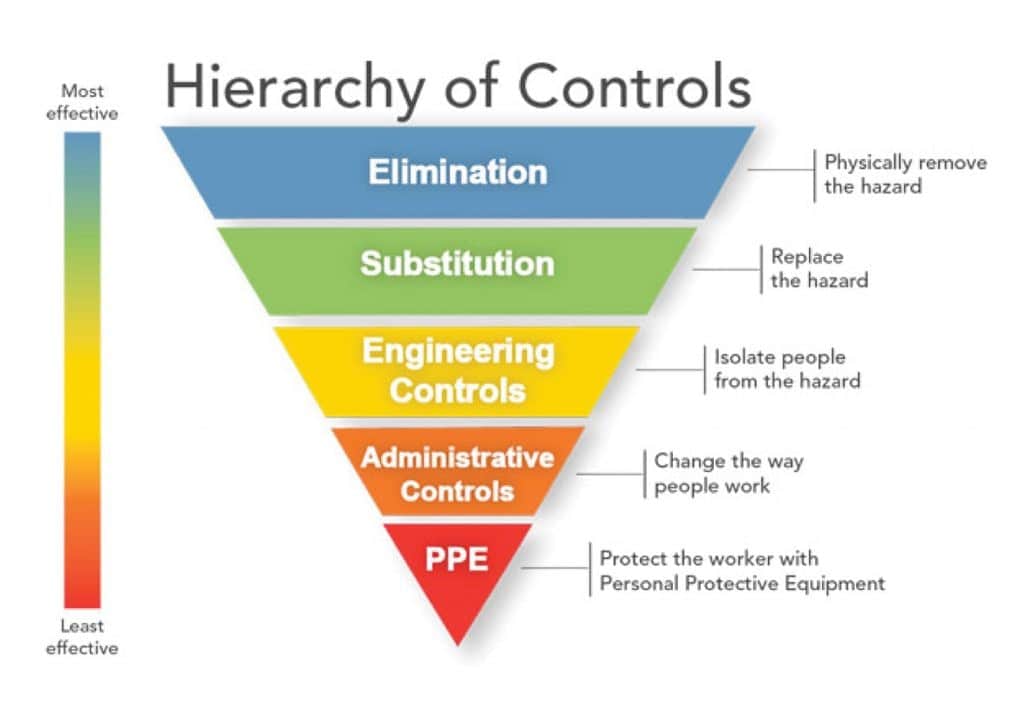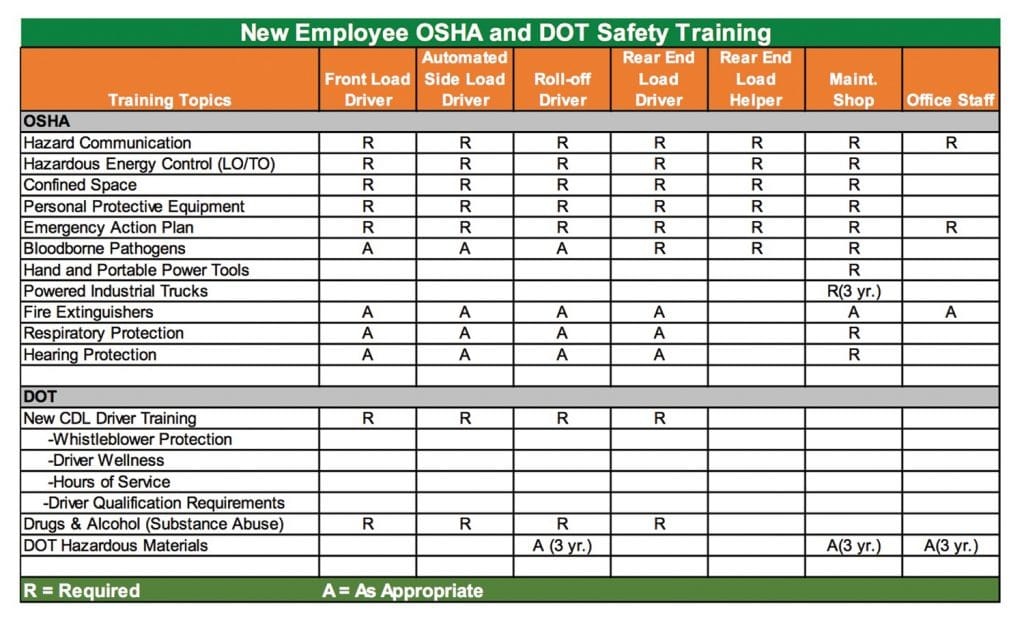Safety training is an investment that will pay dividends in the long run through lower worker’s compensation rates and lower overall labor costs. A well-designed safety training program will help prevent injuries, prevent regulatory citations, improve moral and lower worker turnover rates.
Lloyd Andrew
In the waste industry, a well thought out and properly designed safety training program can provide huge advantages over competitors. All waste companies have trucks and equipment; what makes the difference are the drivers, operators, and maintenance personnel who operate and maintain that equipment.
People want to work for a company where safety is a core value. This lowers worker turnover and results in lower labor costs associated with training new workers. Additionally, municipalities are looking at a waste company’s safety record when awarding contracts.
Conversely, poorly designed and executed safety training results in workers being injured and/or the company receiving fines and penalties from regulatory agencies. These increased operating costs may not be readily visible and include worker’s compensation rate increases and labor cost increases to hire and train replacement workers, which results in decreased collection route efficiencies. Unfortunately, many waste companies do not recognize these hidden costs and do not take advantage of the opportunity to proactively communicate the message that worker safety is critical to the success of the company.
Some waste company managers do not want to make the investment of time and money into a safety training program. Even though it is the best method of protecting a company’s most important production tool—its employees. Much of the knowledge about how a worker performs their job is passed along through OJT (On the Job Training). It is the way the job has been done for years. However, it may not be the safest and most efficient method of performing the job. Training drivers on safe routing explains that backing out of a front load container onto a busy street at 5:15 pm may seem like a time saver but driving around the block may be a safer and potentially better method of picking up that customer’s container.
Safety training is a way to reinforce the importance of doing a job correctly and safely. Otherwise, workers become complacent and may figure out a way to shortcut a work task, increasing the risk of an accident or injury. Effective safety training must reinforce why it is important not to take shortcuts. Formal safety training programs are a way to ensure that workers are provided with the necessary information on how a job is to be completed safely, not just how the job has been done in the past through OJT.
Many waste companies do not have the staff resources to develop and conduct safety training sessions customized specifically to the waste industry. Safety training is typically conducted in a classroom listening to a person talk about a randomly selected safety topic. Or the company will buy a generic DVD or video about manufacturing widgets or working at a chemical plant operation and have their workers watch it. This is not only disengaging to workers, but it also shows that the company does not place enough importance on safety to take the time to train workers on the safe work practices, which apply to their jobs. This training may help comply with the regulatory requirement to train workers on a particular subject, but it will not help with the more important aspect of safety training, which is worker engagement.
Designing an Effective Safety Training Program
It is important to take the time to design an effective safety training program. Waiting until the end of the month to look up a random safety topic on the Internet is not going to result in an effective safety program. Training new employees should be a top priority. The training program should be designed to ensure workers know how to do their job safely and efficiently.
The safety training program must also address the needs of existing workers. It should be designed to reinforce safe work practices and keep these concepts fresh in workers minds. It helps demonstrate the importance the company places on safety, which will improve moral by showing that the company cares about its workers.
Design flexibility into the program to allow for those unexpected and appropriate safety topics. When there is a waste industry-related incident, which can be used as a well-timed training topic, such as waste vehicles crossing railroad tracks, incorporate these into your program.
The specific topics a company should spend their time training on depends on several factors. An evaluation of your company’s operation should be conducted. Then use this information to create your safety training program. To help focus your training efforts and maximize the return on your safety training investment, first review your company’s accident and injury trends. If it shows workers are suffering from musculoskeletal strains and sprains, schedule a training session on body mechanics, conditioning and safe lifting. Use your safety training to address workers’ lack of knowledge about how to perform a job task properly and explain the safe work procedures that should be followed. To help ensure your safety training is well designed, engage workers and supervisors to help create the program. They can provide valuable input on topics where they feel they need more training.
Keep in mind safety training does have its limitations. Training is an administrative control; it requires workers to implement the information being provided, which is why it is vital to take the time to design your company’s safety training program. A more effective method of preventing incidents would be to design out the hazard or implement engineering controls, but this may be costly or impractical to implement. To help explain Figure 1, let’s use backing as the safety training topic. Your driver and operator safety training session would explain and show the importance of recognizing equipment blind spots and the importance of frequently scanning and using mirrors when backing. This is an administrative control, changing the way people work. However, a more effective control would be elimination or physically removing the hazard. This can be done by eliminating the blind spot by installing a rear vision camera on the equipment.

Define the objectives of the safety training topic. It is important to determine the specific actions, skills, or knowledge that you want a worker to do or possess after the training. Otherwise, the safety training may not be specific enough to achieve the training objective. These learning objectives should be concrete and specific to the job: wearing their reflective vests properly, not under their jackets; understanding how to read chemical container labels; or never walking under a raised tailgate when cleaning around the rear seal of a packer body.
Understand it is important to engage workers in the training subject. Think about your last few safety training sessions. Were these safety training sessions thoughtfully designed to ensure workers could readily apply their newly learned skills to their particular job? For a collection company, using a generic guarding safety training video that stresses the importance of not operating a conveyor without a guard over the head and tail pulleys is not useful, since these workers do not work around conveyors. However, for MRF workers this example would be appropriate.
Be sure to include knowledge checks during the training session; have the instructor ask probing questions requiring an answer from the training participants. This is reinforcing the training through repetition.
After the training is completed, it is important to test workers’ knowledge of the subject matter to ensure that they understood the topic. At the end of the training, incorporate a written (or verbal) test that requires the participant to recall the information that was presented.
New Employee Safety Training Example
In the waste services and related industries, there are a wide variety of safety training topics that could be included in the safety training curriculum. The training at a waste services company should be designed to ensure workers do not get hurt by explaining the hazards of the job and how to control or minimize the risk of those hazards. Focusing on your particular business needs will help guide which areas a company should spend more time on when designing their safety training program.
Regulatory safety training requirements are used in Figure 2, since those are applicable to most companies. Figure 2 was created to help guide waste hauling companies on how to design their regulatory required safety training. The table contains a listing of the required safety training topics to comply with OSHA’s and DOT’s specific training requirements and is listed by collection system. This is not a list of all the required safety topics, but includes the higher priority topics.

Waste industry supervisors are busy with routing, customer relations, equipment breakdown issues and a myriad of other things. Having the time to train every new hire driver on this extensive list of regulatory required safety topics is daunting.
To address this issue, some waste industry companies are using online learning systems to address these safety training requirements. A few training companies, focused on the waste industry, have developed customized online safety training programs. These safety training programs can be delivered to new workers at their own learning pace on desktop computers, smart phones or tablets.
Online training has progressed from the days of simply watching a computer screen for 15 minutes, waking up at the end and taking a short quiz. Now, programs have thought-provoking questions imbedded in the training to ensure workers understand the concept being taught. Workers must respond before they can proceed to the next portion of the online training class. These online learning systems allow supervisors to spend their time reinforcing and coaching workers on the safe work procedures, which were explained in the training.
After your safety training sessions, ask for feedback on the training. Ask workers what they specifically learned during the safety training and what they are going to do differently at work when back on the job.
Finally, track progress to see if the safety training program is effectively reducing accidents and injuries or improving worker habits.
Use it or Lose It
When designing your safety training program, remembering the phrase “use it or lose it,” will prompt you to incorporate activities after the training to help workers retain the information presented. The training must be followed up with observations and proper supervisory reinforcement. This is where many waste companies miss the opportunity in the design of their safety training program. The goal is to change, or reinforce, a worker’s safe behavior.
Some of the information will be forgotten within a week, unless the training is reinforced on the job through supervisory observations of worker habits followed by coaching after the observation. Use visual reminders like posters or have dispatch do a shout out over the radio related to the monthly topic; for example, “don’t forget to keep your eyes moving and look well down the road to pick up hazards early so you have time to safely respond to a hazardous situation ahead.”
Ultimately, workers need to be observed working to ensure that they are properly and effectively implementing the safety training than they have received. Having supervisors conduct observations and provide positive feedback for performing a work task safely is one of the best motivators.
Safety training is an investment that will pay dividends in the long run through lower worker’s compensation rates and lower overall labor costs. A well-designed safety training program will help prevent injuries, prevent regulatory citations, improve moral and lower worker turnover rates; thereby, reducing a company’s operating costs.
Lloyd B. Andrew III, CIH, CSP, serves on the Safety Advisory Board of Waste Industry Training, a provider of LMS-based online safety training programs tailored specifically to the waste industry. He can be reached at (713) 589-9929, e-mail [email protected] or visit www.WasteIndustryTraining.com.
